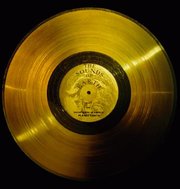Whale song
|
|
A whale song is the collection of sounds made by whales to communicate. The word "song" is used in particular to describe the pattern of predictable and repetitious sounds made by certain species of whales (notably the humpback whale) in a manner that to cetologists is reminiscent of human singing.
The biological processes used to produce sound vary from one family of cetaceans to another. However, all whales, dolphins, and porpoises are much more dependent on sound for communication and sensation than their terrestrial cousins because the absorption of light by water makes sight difficult and because the relatively slow movement of water compared to air decreases the effectiveness of the sense of smell. Increased ambient noise in the world's oceans due to shipping gives rise to environmentalists' concerns that humans are destroying this important feature of the marine habitat.
| Contents |
Production of sound
Humans produce sound by expelling air through the larynx. The vocal cords within the larynx open and close as necessary to separate the stream of air into discrete pockets of air. These pockets are shaped by the throat, tongue, and lips into the desired sound.
Cetacean sound production differs markedly from this mechanism. The precise mechanism differs in the two major sub-families of cetaceans: the Odontoceti (toothed whales—including dolphins) and the Mystceti (baleen whales—including the largest whales, such as the blue whale).
Toothed whale sound production
Dolphin_head_sound_production.PNG
Toothed whales do not make the long, low-frequency sounds known as the whale song. Instead they produce rapid bursts of high-frequency clicks and whistles. Single clicks are generally used for echolocation whereas collections of clicks and whistles are used for communication. Though a large pod of dolphins will make a veritable cacophony of different noises, very little is known about the meaning of the sound. Frankell (1998) quotes one researcher characterizing listening to such a school as like listening to a group of children at a playground.
The sounds themselves are produced by passing air through a structure in the head rather like the human nasal passage called the phonic lips. As the air passes through this narrow passage, the phonic lip membranes are sucked together, causing the surrounding tissue to vibrate. These vibrations can, as with the vibrations in the human larynx, be unconsciously controlled with great sensitivity. The vibrations pass through the tissue of the head to the melon, which shapes and directs the sound into a beam of sound for echolocation. Every toothed whale except the Sperm Whale has two sets of phonic lips and is thus capable of making two sounds independently. Once the air has passed the phonic lips it enters the vestibular sac. From there the air may be recycled back into the lower part of the nasal complex, ready to be used for sound creation again, or passed out through the blowhole.
The French name for phonic lips—museau de singe—translates to "monkey lips," which the phonic lip structure is supposed to resemble. New cranial analysis using computed axial and single photon emission computed tomography scans in 2004 showed that, at least in the case of bottlenose dolphins, air may be supplied to the nasal complex from the lungs by the palatopharyngeal sphincter, enabling the sound creation process to continue for as long as the dolphin is able to hold their breath (Houser et al., 2004).
Baleen whale sound production
Baleen whales do not have phonic lip structure. Instead they have a larynx that appears to play a role in sound production, but it lacks vocal chords and scientists remain uncertain as the exact mechanism. The process, however, cannot be completely analogous to Humans because whales do not have to exhale in order to produce sound. It is likely that they recycle air around the body for this purpose. Cranial sinuses may also be used to create the sounds, but again researchers are currently unclear how.
Purpose of whale-created sounds
While the complex and haunting sounds of the Humpback Whale (and some Blue Whales) are believed to be primarily used in sexual selection (see section below), the simpler sounds of other whales have a year-round use. While toothed dolphins (including the orca) are capable of using echolocation (essentially the emission of ultra-sonic beams of sound waves) to detect the size and nature of objects very precisely, baleen whales do not have this capability. Further, unlike some fish such as sharks, a whale's sense of smell is not highly developed. Thus given the poor visibility of aquatic environments and the fact that sound travels so well in water, human-audible sounds play a role in such whales' navigation. For instance, the depth of water or the existence of a large obstruction ahead may be detected by loud noises made by baleen whales.
The song of the Humpback Whale
Akhumps_128_016_0_500c.gif
Two groups of whales, the Humpback Whale and the subspecies of Blue Whale found in the Indian Ocean, are known to produce the repetitious sounds at varying frequencies known as the whale song. Marine biologist Philip Clapham describes the song as "probably the most complex [songs] in the animal kingdom" (Clapham, 1996).
Male Humpback Whales perform these vocalizations only during the mating season, and so it is surmised the purpose of songs is to aid sexual selection. Whether the songs are a competitive behaviour between males seeking the same mate, a means of defining territory or a "flirting" behaviour from a male to a female is not known and the subject of on-going research.
Interest in the whale song was aroused by researchers Roger Payne and Scott McVay, who analysed the songs in 1971. The songs follow a distinct hierarchical structure. The base units of the song (sometimes loosely called the "notes") are single uninterrupted emissions of sound that last up to a few seconds. These sounds vary in frequency from 20 Hz to 10 kHz (the typical Human range of hearing is 20 Hz to 20 kHz). The units may be frequency modulated (i.e., the sound may go up, go down, or stay the same during the note) or amplitude modulated (get louder or quieter).
A collection of four or six units is known as a sub-phrase, lasting perhaps ten seconds. A collection of two sub-phrases is a phrase. A whale will typically repeat the same phrase over and over for two to four minutes. This is known as a theme. A collection of themes is known as a song. The whale will repeat the same song, which last perhaps twenty minutes, over and over again over the course of hours or even days. This "Russian doll" hierarchy of sounds has captured the imagination of scientists.
Further, each whale's song will slowly evolve over time. For example, over the course of a month a particular unit that started as an "upsweep" (increasing in frequency) may slowly flatten to become a constant note. Another unit may get steadily louder. The pace of evolution of a whale's song also changes—some years the song may change quite rapidly, whereas in other years little variation may be recorded.
Whales occupying the same geographical areas tend to sing similar songs, with only slight variations. Whales from non-overlapping regions sing entirely different collections of units.
As the song evolves it appears that old patterns are not revisited. An analysis of 19 years of whale songs found that while general patterns in song could be spotted, the same combinations never recurred.
Humpback Whales may also make stand-alone sounds that do not form part of a song, particularly during courtship rituals. Finally, the Humpbacks make a third class of sound called the feeding call. This is a long sound (5 to 10 s duration) of near constant frequency. Humpbacks generally feed co-operatively by gathering in groups, swimming underneath shoals of fish and all lunging up vertically through the fish and out of the water together. Prior to these lunges, whales make their feeding call. The exact purpose of the call is not known, but research suggests that fish do know what it means. When the sound was played back to them, a group of herring responded to the sound by moving away from the call, even though no whale was present.
Other whale sounds
Most baleen whales make sounds at about 15–20 hertz. However, marine biologists at the Woods Hole Oceanographic Institution reported in the New Scientist in December 2004 that they had been tracking a whale in the North Pacific for 12 years that was "singing" at 52 Hz. The scientists are currently unable to explain this dramatic difference from the norm; however, they are sure the whale is a baleen and extremely unlikely to be a new species, suggesting that currently known species may have a wider vocal range than previously thought.
Most other whales and dolphins produce sounds of varying degrees of complexity. Of particular interest is the Beluga (the "sea canary") which produces an immense variety of whistles, clicks and pulses.
Human interaction
Though some observers suggest that undue fascination has been placed on the whales' songs simply because the animals are under the sea, most marine mammal scientists believe that sound plays a particularly vital role in the development and well-being of cetaceans. It may be argued those against whaling have anthropomorphized the behaviour in an attempt to bolster their case. Conversely pro-whaling nations are perhaps disposed to downplay the meaning of the sounds, noting for example that little is taken in the "moo" of cattle.
Researchers use hydrophones (often adapted from their original military use in tracking submarines) to ascertain the exact location of the origin of whale noises. Their methods allow them also to detect how far throughout an ocean a sound travels. Research by Dr Christopher Clark of Cornell University conducted using thirty-years worth of military data showed that whale noises travel up to 3,000 km. As well as providing information about song production, the data allows researchers to follow the migratory path of whales throughout the "singing" (mating) season.
Prior to the introduction of human noise production, Clark says the noises may have travelled right from one side of an ocean to the other. His research indicates that ambient noise from boats is doubling each decade. This has the effect of halving the range of whale noises. Those that do believe the whale songs are significant to the continued well-being of well-populations are particularly concerned by this increase in ambient noise. Other research has shown that increased boat traffic in, for example, the waters off Vancouver, has caused some orca to change the frequency and increase the amplitude of their sounds, in an apparent attempt to get themselves heard. Environmentalists fear that such boat activity is putting undue stress on the animal as well as making it difficult to find a mate.
Media
Template:Multi-listen start Template:Multi-listen item Template:Multi-listen item Template:Multi-listen item Template:Multi-listen item Template:Multi-listen item Template:Multi-listen end

References
- Lone whale's song remains a mystery, New Scientist, issue number 2477, 11th December 2004
- Sound production, by Adam S. Frankell, in the Encyclopedia of Marine Mammals (pp 1126-1137) ISBN 0125513402 (1998)
- In search of impulse sound sources in odontocetes by Ted Cranford in Hearing by Whales and Dolphins (W. Lu, A. Popper and R. Fays eds.). Springer-Verlag (2000).
- Progressive changes in the songs of Humpback Whales (Megaptera novaeangliae): a detailed analysis of two seasons in Hawaii by K.B.Payne, P. Tyack and R.S. Payne in Communication and behavior of whales. Westview Press (1983)
- BBC News, 28th February 2005. Unweaving the song of whales (http://news.bbc.co.uk/1/hi/sci/tech/4297531.stm)
- Template:Book reference
- Template:Journal reference
External links
- Cornell University's whale communication research webpage (http://www.birds.cornell.edu/brp/ResWhale.html)de:Walgesang
fr:Chant des baleines ko:고래의 노래 he:שירת הלווייתן nl:Walvisgezang ja:クジラの歌 ru:Песни китов scn:Cantu dî citacei zh:鲸语


